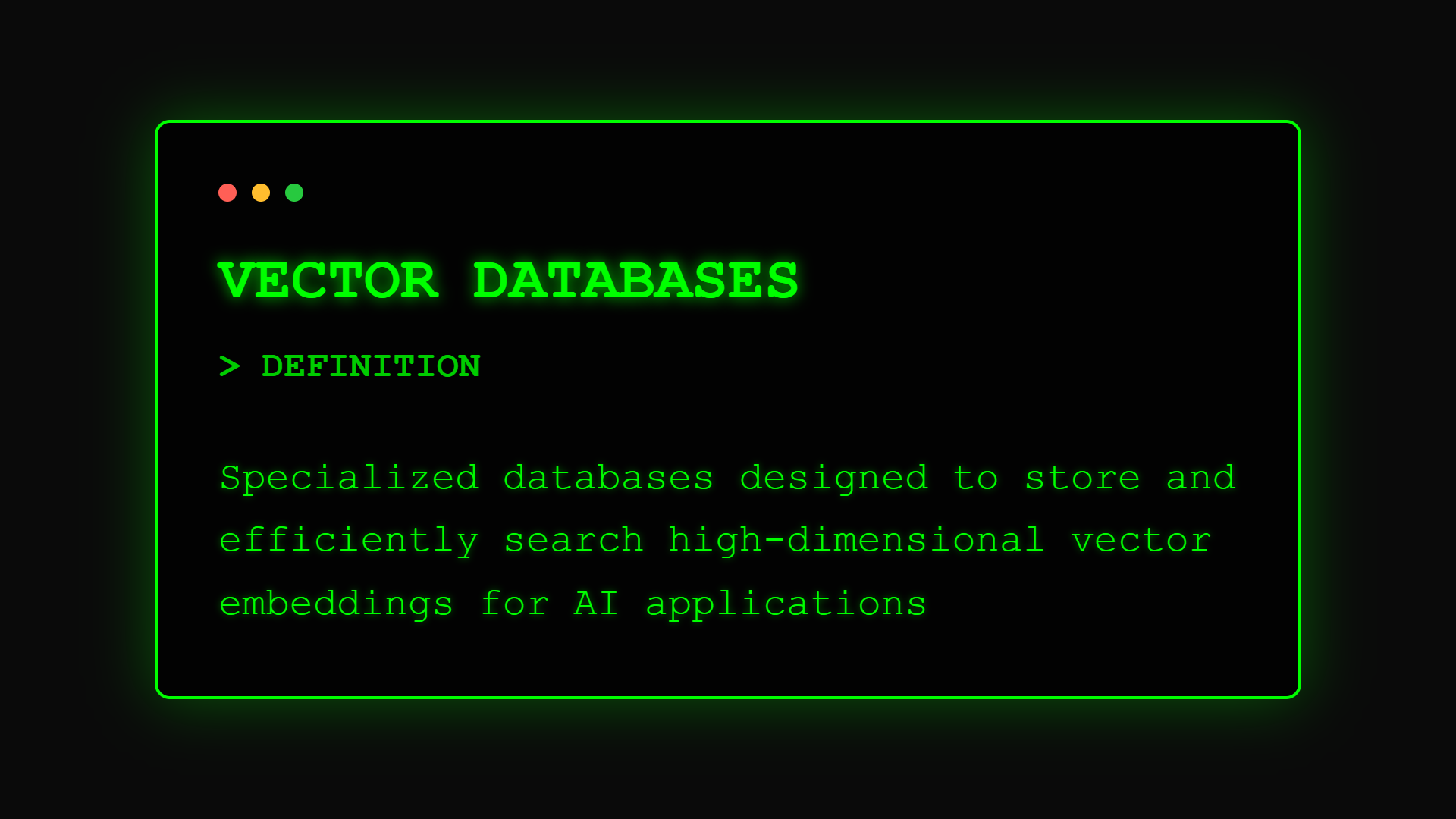AI Terms
What are Vector Databases? Where AI Stores Its Understanding

Traditional databases search for exact matches. But how do you search for "similar meanings" or "related concepts"? Vector databases solve this, storing AI's understanding of your data and finding connections that keyword search misses. They're the infrastructure powering modern AI applications.
Technical Definition
Vector databases are specialized database systems designed to store, index, and query high-dimensional vectors (embeddings) efficiently. Unlike traditional databases that handle structured data with exact matches, vector databases excel at similarity search across millions or billions of numerical representations.
According to industry analysts, "Vector databases are purpose-built to handle the embeddings that power modern AI applications, using specialized indexing algorithms to perform similarity searches at scales impossible with conventional databases."
These systems use algorithms like Hierarchical Navigable Small World (HNSW) graphs or Inverted File (IVF) indexes to find nearest neighbors in high-dimensional space without checking every vector.
Business Value
For business leaders, vector databases are the infrastructure that makes AI-powered search, recommendations, and personalization work at enterprise scale – think of them as Google for your company's knowledge and relationships.
Imagine having a librarian who doesn't just find books by title, but understands concepts and connections – finding everything related to your query even if it uses different words. That's what vector databases do for your AI applications.
In practical terms, vector databases enable chatbots that understand context, recommendation engines that grasp preferences, fraud detection that spots subtle patterns, and knowledge bases that surface relevant information regardless of phrasing.
Core Capabilities
Vector databases provide:
• Similarity Search: Find vectors closest to a query vector, enabling "find similar" functionality across any data type
• Hybrid Search: Combine vector similarity with traditional filters like date ranges, categories, or metadata
• Real-time Indexing: Add new vectors and immediately search them without rebuilding entire indexes
• Scalability: Handle billions of vectors while maintaining sub-second query speeds through distributed architecture
• Multi-modal Support: Store embeddings from text, images, audio, and other data types in unified searchable format
How Vector Databases Work
The vector database process:
Vector Ingestion: Embeddings from AI models stored with metadata (IDs, timestamps, categories, source data)
Index Building: Specialized algorithms create search structures that partition vector space for efficient navigation
Query Processing: Search requests converted to vectors, then algorithms find nearest neighbors without exhaustive search
Result Ranking: Most similar vectors returned with similarity scores, often combined with business logic
Continuous Updates: New vectors added and indexes updated incrementally, maintaining search performance
Vector Database Technologies
Leading platforms and their strengths:
Platform 1: Pinecone Strengths: Fully managed, easy scaling Best for: Rapid deployment, SaaS applications Scale: Billions of vectors
Platform 2: Weaviate Strengths: Open source, hybrid search Best for: Enterprise deployments, complex queries Features: Built-in ML models
Platform 3: Qdrant Strengths: High performance, flexible filtering Best for: Real-time applications Architecture: Rust-based efficiency
Platform 4: Milvus Strengths: Open source, GPU acceleration Best for: Large-scale deployments Community: Strong ecosystem
Real-World Applications
Vector databases in production:
E-commerce Example: Shopify's vector database powers visual search across millions of products, allowing customers to find similar items by uploading photos, increasing conversion rates by 30% compared to text search.
Media Example: Spotify stores song embeddings in vector databases to power Discover Weekly, analyzing listening patterns to find musically similar tracks across 100 million songs, driving 40% of user engagement.
Enterprise Search Example: Microsoft uses vector databases in Bing to understand search intent, finding relevant results even when queries don't match keywords, improving user satisfaction by 25%.
Use Cases Across Industries
Where vector databases excel:
Customer Service:
- FAQ matching beyond keywords
- Ticket similarity for routing
- Knowledge base search
- Agent assistance recommendations
Financial Services:
- Fraud pattern detection
- Document similarity for compliance
- Customer segmentation
- Risk assessment clustering
Healthcare:
- Patient similarity for treatment
- Medical image matching
- Research paper discovery
- Drug interaction analysis
Manufacturing:
- Defect pattern matching
- Maintenance prediction
- Supply chain optimization
- Quality clustering
Implementation Considerations
Key decisions for deployment:
Technical Choices:
- Cloud vs. on-premise deployment
- Open source vs. managed service
- Single vs. distributed architecture
- CPU vs. GPU acceleration
Performance Factors:
- Vector dimensions (384-1536 typical)
- Index type selection
- Query speed requirements
- Update frequency needs
Integration Needs:
- Embedding model compatibility
- API design for applications
- Monitoring and observability
- Backup and recovery
Common Challenges
Obstacles and solutions:
• Curse of Dimensionality: High dimensions make search harder → Solution: Dimension reduction and better indexing algorithms
• Index Bloat: Indexes can exceed data size → Solution: Compression techniques and selective indexing
• Concept Drift: Embeddings become outdated → Solution: Versioning and regular recomputation
• Hybrid Requirements: Need both vector and traditional search → Solution: Platforms supporting unified queries
Getting Started
Your path to vector-powered AI:
- Understand Embeddings that vectors represent
- Learn about Semantic Search applications
- Explore RAG using vector databases
- Read our Vector Database Selection Guide
FAQ Section
Frequently Asked Questions about Vector Databases
Part of the [AI Terms Collection]. Last updated: 2025-01-11